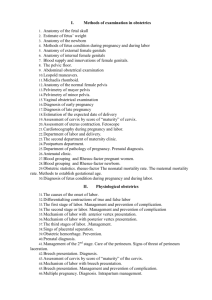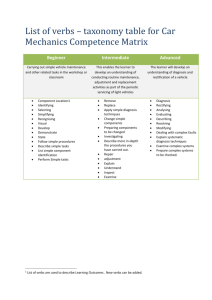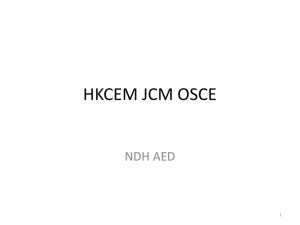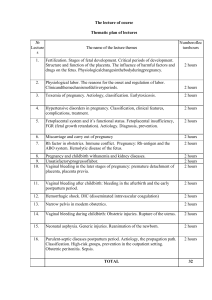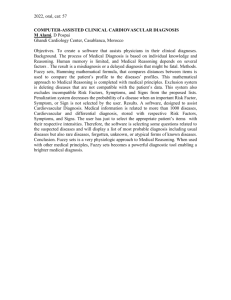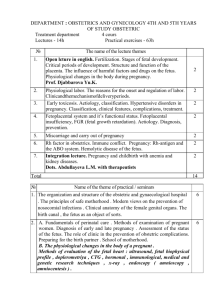Obstetrics and Gynaecology
advertisement
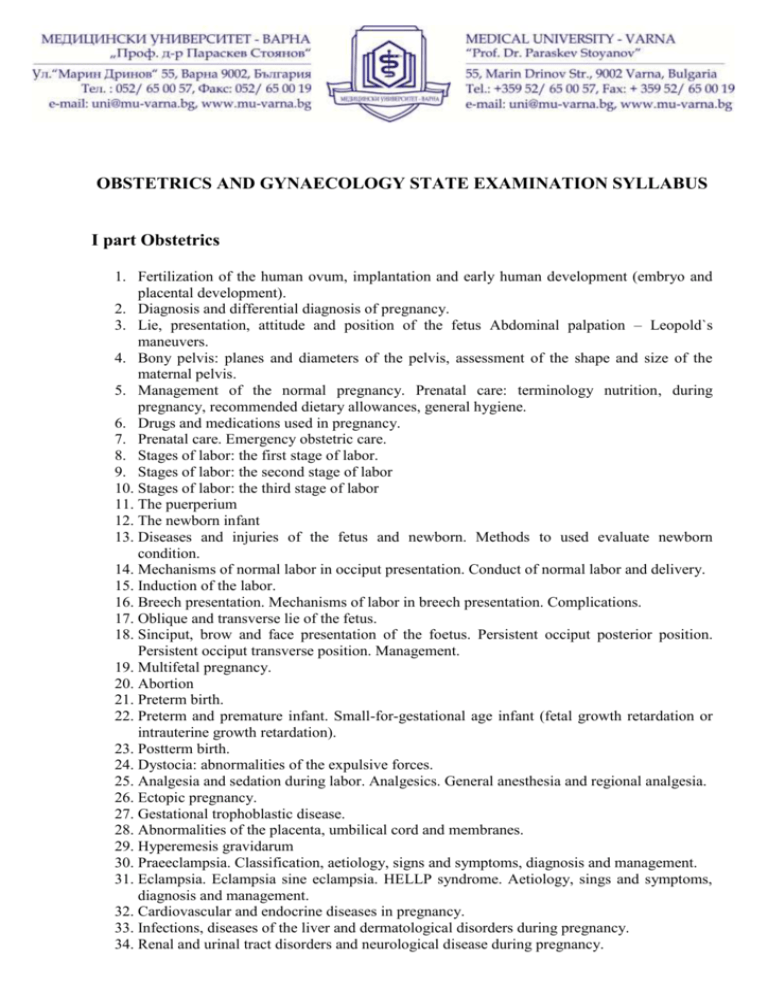
OBSTETRICS AND GYNAECOLOGY STATE EXAMINATION SYLLABUS I part Obstetrics 1. Fertilization of the human ovum, implantation and early human development (embryo and placental development). 2. Diagnosis and differential diagnosis of pregnancy. 3. Lie, presentation, attitude and position of the fetus Abdominal palpation – Leopold`s maneuvers. 4. Bony pelvis: planes and diameters of the pelvis, assessment of the shape and size of the maternal pelvis. 5. Management of the normal pregnancy. Prenatal care: terminology nutrition, during pregnancy, recommended dietary allowances, general hygiene. 6. Drugs and medications used in pregnancy. 7. Prenatal care. Emergency obstetric care. 8. Stages of labor: the first stage of labor. 9. Stages of labor: the second stage of labor 10. Stages of labor: the third stage of labor 11. The puerperium 12. The newborn infant 13. Diseases and injuries of the fetus and newborn. Methods to used evaluate newborn condition. 14. Mechanisms of normal labor in occiput presentation. Conduct of normal labor and delivery. 15. Induction of the labor. 16. Breech presentation. Mechanisms of labor in breech presentation. Complications. 17. Oblique and transverse lie of the fetus. 18. Sinciput, brow and face presentation of the foеtus. Persistent occiput posterior position. Persistent occiput transverse position. Management. 19. Multifetal pregnancy. 20. Abortion 21. Preterm birth. 22. Preterm and premature infant. Small-for-gestational age infant (fetal growth retardation or intrauterine growth retardation). 23. Postterm birth. 24. Dystocia: abnormalities of the expulsive forces. 25. Analgesia and sedation during labor. Analgesics. General anesthesia and regional analgesia. 26. Ectopic pregnancy. 27. Gestational trophoblastic disease. 28. Abnormalities of the placenta, umbilical cord and membranes. 29. Hyperemesis gravidarum 30. Praeeclampsia. Classification, aetiology, signs and symptoms, diagnosis and management. 31. Eclampsia. Eclampsia sine eclampsia. HELLP syndrome. Aetiology, sings and symptoms, diagnosis and management. 32. Cardiovascular and endocrine diseases in pregnancy. 33. Infections, diseases of the liver and dermatological disorders during pregnancy. 34. Renal and urinal tract disorders and neurological disease during pregnancy. 35. Pelvic contraction. 36. Placenta praevia. 37. Trauma of the mother during labor and delivery. 38. Rupture of the uterus and other genital tract lacerations (injuries). 39. Differential diagnosis of hypovolemic shock. 40. Placental abruption (abruption placentae). 41. Haemorrhage during the third stage of labor (before and after delivery of the placenta). 42. Disseminated intravascular coagulation (DIC sd.) syndrome. 43. Haemorrhage during the puerperium. Thromboembolic disease. 44. Lactation and disorders of the breasts feeding. Mastitis. 45. Puerperal infection (mastitis not included). 46. Intrauterine and postnatal distress of the fetus asphyxia foeti and newborn infant. 47. Fetal distress. Ultrasonography. Screening programs ( assessment of maternal serum markers). Magnetic resonance imaging. Etiology. 48. Contraction stress testing and nonstress testing. Amniocentesis. 49. Preimplantation genetic diagnosis (PGD). Treatment and prophylaxis. 50. Rh – isoimmunization. 51. Prostaglandins used in obstetrics. II part 52. Adaptation of the newborn to air breathing. 53. Induced abortion (therapeutic and elective abortion). Abortion techniques (surgical and medical techniques). 54. Shoulder dystocia. 55. Forceps delivery – without rotation. 56. Forceps delivery – with rotation (≤45 degrees or ≥45 degrees). 57. Vacuum extraction. 58. Techniques for vaginal breech delivery. Spontaneous and partial breech extraction. Bracht maneuver. Zovianov maneuver. Muller maneuver. Lovset maneuver. Classical maneuver. 59. Techniques for vaginal breech delivery. Extraction of the aftercoming head of the fetus. Mauriceau- Levret-Veit – Smellie maneuver. Forceps to aftercoming head. 60. External cephalic version. Internal podalic version. 61. Total breech extraction. 62. Version of the fetus. John Braxton Hicks maneuver. 63. Cesarean delivery. Classification. Indications and contraindications for Cesarean Section. 64. Manual removal of placenta. Revisio cevi uteri manualis et instrumentalis. 65. Packing the uterus and other methods for management of uterine atony. III part GYNAECOLOGY 66. Menstrual cycle. Regulation. 67. Factors and hormones. Toxic shock syndrome (Tod`s syndrome). 68. Amenorrhoea. Dysmenorrhoea (algomenorrhoea). 69. Dysfunctional uterine bleeding. Diagnosis and differential diagnosis. 70. Pediatric and adolescent gynecology. 71. Climacterium (Menopause). Hormone replacement therapy. Osteoporosis. 72. Diseases of the vulva and vagina. 73. Non inflammatory diseases of the external and internal genitalia. 74. Inflammatory diseases of the uterus, adnexa and parametrium. 75. Pelvic inflammatory disease (PID). 76. Emergency gynaecological care. Diagnosis, differential diagnosis and management. 77. Uterine fibroids. Management. 78. Endometriosis. Managemetn. 79. Cervical cancer. 80. Cervical precancer. Cervical screening. 81. Endometrial carcinoms. Sarcoma and mixed mesodermal tumours of the uterus. Screening mеthods (techniques). 82. Benign ovarian tumours. 83. Malignant ovarian tumours. 84. Infertility. Male infertility. Etiology. Diagnosis. Treatment and prophylaxis. 85. Infertility Female infertility. Etiology. Diagnosis. Treatment and prophylaxis. 86. Assisted reproductive technologies (ART). Intrauterine insemination (IUS), In vitro fertilization (IVF), Intracytoplasmic sperm injection (ICSI). 87. Abnormalities of the genitalia (reproductive tract). 88. Urinary incontinence. 89. Family planning. Contraception. 90. Antibiotic therapy. Prevention in obstetrics and gynaecology.
